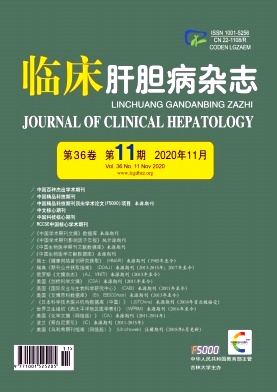|
[1]SONG YN,ZHANG GB,LU YY,et al.Huangqi decoction alleviates dimethylnitrosamine-induced liver fibrosis:An analysis of bile acids metabolic mechanism[J].J Ethnopharmacol,2016,189:148-156.
|
|
[2]ABT MC,MCKENNEY PT,PAMER EG.Clostridium difficile colitis:Pathogenesis and host defence[J].Nat Rev Microbiol,2016,14(10):609-620.
|
|
[3]XIONG A,YANG F,FANG L,et al.Metabolomic and genomic evidence for compromised bile acid homeostasis by senecionine,a hepatotoxic pyrrolizidine alkaloid[J].Chem Res Toxicol,2014,27(5):775-786.
|
|
[4] GUO C,XIE S,CHI Z,et al.Bile acids control inflammation and metabolic disorder through inhibition of NLRP3 inflammasome[J].Immunity,2016,45(4):944.
|
|
[5]ZHANG R,HUANG T,ZHANG Q,et al.Xiaoyan lidan formula amelioratesα-naphthylisothiocyanate-induced intrahepatic cholestatic liver injury in rats as revealed by non-targeted and targeted metabolomics[J].J Pharm Biomed Anal,2020,179:112966.
|
|
[6]WANG N,YANG B,ZHANG J,et al.Metabolite profiling of traditional Chinese medicine XIAOPI formula:An integrated strategy based on UPLC-Q-Orbitrap MS combined with network pharmacology analysis[J].Biomed Pharmacother,2020,121:109569.
|
|
[7]CHIANG JY.Regulation of bile acid synthesis:Pathways,nuclear receptors,and mechanisms[J].J Hepatol,2004,40(3):539-551.
|
|
[8]MERTENS KL,KALSBEEK A,SOETERS MR,et al.Bile acid signaling pathways from the enterohepatic circulation to the central nervous system[J].Front Neurosci,2017,11:617.
|
|
[9]MAZER NA,BENEDEK GB,CAREY MC.Quasielastic lightscattering studies of aqueous biliary lipid systems.Mixed micelle formation in bile salt-lecithin solutions[J].Biochemis-try,1980,19(4):601-615.
|
|
[10]KUBITZ R,DROGE C,STINDT J,et al.The bile salt export pump(BSEP)in health and disease[J].Clin Res Hepatol Gastroenterol,2012,36(6):536-553.
|
|
[11]CHAWLA A,REPA JJ,EVANS RM,et al.Nuclear receptors and lipid physiology:Opening the X-files[J].Science,2001,294(5548):1866-1870.
|
|
[12]SAINI SP,SONODA J,XU L,et al.A novel constitutive androstane receptor-mediated and CYP3A-independent pathway of bile acid detoxification[J].Mol Pharmacol,2004,65(2):292-300.
|
|
[13]STAUDINGER JL,GOODWIN B,JONES SA,et al.The nuclear receptor PXR is a lithocholic acid sensor that protects against liver toxicity[J].Proc Natl Acad Sci U S A,2001,98(6):3369-3374.
|
|
[14]SONG C,HIIPAKKA RA,LIAO S.Selective activation of liver X receptor alpha by 6alpha-hydroxy bile acids and analogs[J].Steroids,2000,65(8):423-427.
|
|
[15]MAKISHIMA M,LU TT,XIE W,et al.Vitamin D receptor as an intestinal bile acid sensor[J].Science,2002,296(5571):1313-1316.
|
|
[16]FIORUCCI S,DISTRUTTI E.Bile Acid-activated receptors,intestinal microbiota,and the treatment of metabolic disorders[J].Trends Mol Med,2015,21(11):702-714.
|
|
[17]DEUTSCHMANN K,REICH M,KLINDT C,et al.Bile acid receptors in the biliary tree:TGR5 in physiology and disease[J].Biochim Biophys Acta Mol Basis Dis,2018,1864(4 Pt B):1319-1325.
|
|
[18]COPPLE BL,LI T.Pharmacology of bile acid receptors:Evolution of bile acids from simple detergents to complex signaling molecules[J].Pharmacol Res,2016,104:9-21.
|
|
[19]STAELS B,FONSECA VA.Bile acids and metabolic regulation:Mechanisms and clinical responses to bile acid sequestration[J].Diabetes Care,2009,32(Suppl 2):s237-s245.
|
|
[20]RIDLON JM,KANG DJ,HYLEMON PB.Bile salt biotransformations by human intestinal bacteria[J].J Lipid Res,2006,47(2):241-259.
|
|
[21] CIPRIANI S,MENCARELLI A,CHINI MG,et al.The bile acid receptor GPBAR-1(TGR5)modulates integrity of intestinal barrier and immune response to experimental colitis[J].PLoS One,2011,6(10):e25637.
|
|
[22]GADALETA RM,van ERPECUM KJ,OLDENBURG B,et al.Farnesoid X receptor activation inhibits inflammation and preserves the intestinal barrier in inflammatory bowel disease[J].Gut,2011,60(4):463-472.
|
|
[23]BIAGIOLI M,CARING A,CIPRIANI S,et al.The bile acid receptor GPBAR1 regulates the M1/M2 phenotype of intestinal macrophages and activation of GPBAR1 rescues mice from murine colitis[J].J Immunol,2017,199(2):718-733.
|
|
[24]SAKANAKA T,INOUE T,YORIFUJI N,et al.The effects of a TGR5 agonist and a dipeptidyl peptidaseⅣinhibitor on dextran sulfate sodium-induced colitis in mice[J].J Gastroenterol Hepatol,2015,30(Suppl 1):60-65.
|
|
[25]RIDLON JM,ALVES JM,HYLEMON PB,et al.Cirrhosis,bile acids and gut microbiota:Unraveling a complex relationship[J].Gut Microbes,2013,4(5):382-387.
|
|
[26]KURDI P,KAWANISHI K,MIZUTANI K,et al.Mechanism of growth inhibition by free bile acids in lactobacilli and bifidobacteria[J].J Bacteriol,2006,188(5):1979-1986.
|
|
[27]ISLAM KB,FUKIYA S,HAGIO M,et al.Bile acid is a host factor that regulates the composition of the cecal microbiota in rats[J].Gastroenterology,2011,141(5):1773-1781.
|
|
[28]KURZ AK,GRAF D,SCHMITT M,et al.Tauroursodesoxycholate-induced choleresis involves p38(MAPK)activation and translocation of the bile salt export pump in rats[J].Gastroenterology,2001,121(2):407-419.
|
|
[29]FICKERT P,ZOLLNER G,FUCHSBICHLER A,et al.Effects of ursodeoxycholic and cholic acid feeding on hepatocellular transporter expression in mouse liver[J].Gastroenterology,2001,121(1):170-183.
|
|
[30]RODRIGUES CM,FAN G,MA X,et al.A novel role for ur-sodeoxycholic acid in inhibiting apoptosis by modulating mitochondrial membrane perturbation[J].J Clin Invest,1998,101(12):2790-2799.
|
|
[31]AMARAL JD,VIANA RJ,RAMALHO RM,et al.Bile acids:Regulation of apoptosis by ursodeoxycholic acid[J].J Lipid Res,2009,50(9):1721-1734.
|
|
[32]SOLA S,CASTRO RE,KREN BT,et al.Modulation of nuclear steroid receptors by ursodeoxycholic acid inhibits TGF-beta1-induced E2F-1/p53-mediated apoptosis of rat hepatocytes[J].Biochemistry,2004,43(26):8429-8438.
|
|
[33]MITSUYOSHI H,NAKASHIMA T,SUMIDA Y,et al.Ursodeoxycholic acid protects hepatocytes against oxidative injury via induction of antioxidants[J].Biochem Biophys Res Commun,1999,263(2):537-542.
|
|
[34]GULDUTUNA S,ZIMMER G,IMHOF M,et al.Molecular aspects of membrane stabilization by ursodeoxycholate[see comment][J].Gastroenterology,1993,104(6):1736-1744.
|
|
[35]CRISPE IN.The liver as a lymphoid organ[J].Annu Rev Immunol,2009,27:147-163.
|
|
[36]KIM I,AHN SH,INAGAKI T,et al.Differential regulation of bile acid homeostasis by the farnesoid X receptor in liver and intestine[J].J Lipid Res,2007,48(12):2664-2672.
|
|
[37]SWANN JR,WANT EJ,GEIER FM,et al.Systemic gut microbial modulation of bile acid metabolism in host tissue compartments[J].Proc Natl Acad Sci U S A,2011,108(Suppl 1):4523-4530.
|
|
[38]MENCARELLI A,RENGA B,MIGLIORATI M,et al.The bile acid sensor farnesoid X receptor is a modulator of liver immunity in a rodent model of acute hepatitis[J].J Immunol,2009,183(10):6657-6666.
|
|
[39]IRACHETA-VELLVE A,CALENDA CD,PETRASEK J,et al.FXR and TGR5 agonists ameliorate liver injury,steatosis,and inflammation after binge or prolonged alcohol feeding in mice[J].Hepatol Commun,2018,2(11):1379-1391.
|
|
[40]FIORUCCI S,BIAGIOLI M,ZAMPELLA A,et al.Bile acids activated receptors regulate innate immunity[J].Front Immunol,2018,9:1853.
|
|
[41]LI H,XI Y,XIN X,et al.Salid roside improves high-fat dietinduced non-alcoholic steatohepatitis by regulating the gut microbiota-bile acid-farnesoid X receptor axis[J].Biomed Pharmacother,2020,124:109915.
|
|
[42]FENG Y,GAO X,MENG M,et al.Multi-omics reveals the mechanisms of antidepressant-like effects of the low polarity fraction of Bupleuri Radix[J].J Ethnopharmacol,2020,256:112806.
|
|
[43]WU DN,GUAN L,JIANG YX,et al.Microbiome and metabonomics study of quercetin for the treatment of atherosclerosis[J].Cardiovasc Diagn Ther,2019,9(6):545-560.
|
|
[44]LI N,WANG B,WU Y,et al.Modification effects of SanWei GanJiang Powder on liver and intestinal damage through reversing bile acid homeostasis[J].Biomed Pharmacother,2019,116:109044.
|
|
[45]ZHANG CH,XIAO Q,SHENG JQ,et al.Gegen Qinlian Decoction abates nonalcoholic steatohepatitis associated liver injuries via anti-oxidative stress and anti-inflammatory response involved inhibition of toll-like receptor 4 signaling pathways[J].Biomed Pharmacother,2020,126:110076.
|
|
[46]WANG GF,LI YY,SHI R,et al.Yinchenzhufu decoction protects against alpha-naphthylisothiocyanate-induced acute cholestatic liver injury in mice by ameliorating disordered bile acid homeostasis and inhibiting inflammatory responses[J].J Ethnopharmacol,2020,254:112672.
|







 DownLoad:
DownLoad: